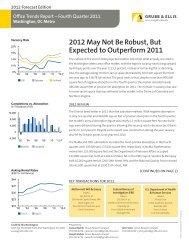Pandemic Preparedness - Grubb & Ellis
Pandemic Preparedness - Grubb & Ellis
Pandemic Preparedness - Grubb & Ellis
You also want an ePaper? Increase the reach of your titles
YUMPU automatically turns print PDFs into web optimized ePapers that Google loves.
insight<br />
<strong>Pandemic</strong> <strong>Preparedness</strong><br />
When disaster strikes:<br />
Ensuring business continuity in the face of a pandemic<br />
Many government and health officials believe that it is only a matter of time until the next<br />
worldwide influenza pandemic occurs. The severity of such an event cannot be foreseen, but<br />
modeling suggests that the impact on the United States and the world could be substantial.<br />
Even a pandemic of limited duration poses serious threats to businesses both large and<br />
small. Although the global spread of a pandemic event cannot be stopped, comprehensive<br />
preparedness can reduce its effects. Consequently, it is of central importance that organizations<br />
take the necessary steps to develop their own incident preparedness and response plans that<br />
are both strong and flexible.<br />
As a global leader in the delivery of commercial real estate services, <strong>Grubb</strong> & <strong>Ellis</strong> is committed<br />
to working with its clients to address the tough real estate issues facing businesses today. As<br />
such, we have developed this paper to share some of the critical issues that users and owners<br />
of real estate should keep in mind when considering the effects of a pandemic on real estate<br />
in their organizations. While this should not be considered a comprehensive disaster plan, it can<br />
be used as a guide to spark ideas, stimulate discussion and prioritize actions when taking steps<br />
to protect your real estate operations.<br />
What’s the big deal<br />
Disaster recovery and business continuity plans are an integral<br />
part of incident preparedness and response. Disaster recovery<br />
ensures quick recovery after a disruptive event, while business continuity<br />
is designed to support critical operations on an ongoing basis.<br />
Real estate services providers have long taken a leading role in<br />
developing sophisticated plans to support these two business<br />
objectives. These plans have evolved over the past few years to<br />
include terrorist attacks and wide-scale disasters such as a hurricane<br />
that might affect an entire business district or metropolitan area.<br />
Despite this kind of preparedness, there is concern that current<br />
approaches to business continuity planning are too “event-specific”<br />
and may not be sufficient to address circumstances – most importantly<br />
the length of time – in which the organization must try to<br />
function during the outbreak of a pandemic disease.<br />
Undoubtedly, many pandemic-related issues will differ considerably<br />
from those posed by natural disasters or a deliberate malicious<br />
attack. Such issues include the potential for a worldwide impact,<br />
escalating absenteeism rates, economic disruptions, financial problems,<br />
interruption of critical services, high demand for alternative<br />
transportation and communications, and the possibility that the<br />
pandemic could last for months or even years. Not only government<br />
and health officials but also smart businesses are devoting considerable<br />
resources to identifying the impact of these issues on their<br />
organizations and determining appropriate responses.<br />
A serious threat<br />
Today, there is no known case of human to human transmission of<br />
influenza virus H5N1 – commonly referred to as “avian flu.” However,<br />
if such transmission were to occur, it would rapidly accelerate the<br />
spread of infection, illness and possible deaths, causing significant<br />
<strong>Grubb</strong> & <strong>Ellis</strong> Summer 2006 1
employee absences to businesses as employees stayed home out<br />
of fear of infection or to care for their families. If avian flu should<br />
spread throughout the United States, estimates claim that it could<br />
kill over 500,000 people, hospitalize more than 2 million, and result<br />
in cumulative labor absentee rates of more than 40 percent for at<br />
least three to four months. It could cost the United States billions<br />
of dollars and the world nearly $2 trillion, disrupting the lives of<br />
millions across the globe. (Bloomberg.com, June 29, 2006; Trust for<br />
America’s Health, 2006).<br />
In light of its global impact and resulting unprecedented absenteeism,<br />
a pandemic event poses many serious challenges to<br />
preparedness and business continuity plans. That a pandemic event<br />
often occurs in successive waves over the course of many months<br />
means that these plans must address both short-term and longterm<br />
issues. Disruptions and uncertainties – including those<br />
affecting power, transportation, telecommunications, water and<br />
public emergency services – only add to the mix of challenges.<br />
Risk reduction and business continuity<br />
Fundamental to business continuity planning are well thought out<br />
risk-reduction strategies. One of the purposes of risk assessment is<br />
to consider additional preventive measures and strategies that could<br />
help reduce the severity of various threats and to proactively implement<br />
procedures or changes quickly where possible and practical.<br />
The aim of business continuity planning is to<br />
mitigate the nearly inevitable business and<br />
economic disruptions that would accompany<br />
a pandemic event.<br />
Disaster recovery outlines the urgent and immediate steps that<br />
need to be taken to get a business up and running after a crisis<br />
event, whereas the aim of business continuity planning is to mitigate<br />
the nearly inevitable business and economic disruptions that<br />
would accompany a pandemic event, lasting more than a few<br />
hours, days or even weeks. Business continuity plans often start<br />
with the identification of essential business functions and activities<br />
(and the personnel and skill sets necessary to keep them running).<br />
In the case of a pandemic, another important aim should be the<br />
minimization and control of illness among employees.<br />
Prior to developing a plan, the following issues should<br />
be considered:<br />
■<br />
■<br />
■<br />
■<br />
Review operations and establish priorities – Determine which<br />
business operations are most critical, and what processes and<br />
resources are required to ensure these operations suffer limited,<br />
if any, interruptions.<br />
Identify roadblocks and ways around them – Outline factors that may<br />
interfere with smooth operations, such as training of personnel,<br />
access to technology, etc., as well as what will be required to navigate<br />
these roadblocks if encountered. Think about what actions<br />
could be taken before a pandemic strikes to reduce its effect on<br />
critical operations and weigh the costs and benefits of early<br />
implementation.<br />
Define the “trigger” for activating your plan – Specify who or what<br />
determines that the company is in “pandemic” mode. Identify<br />
a spokesperson, prepare standard communications that can<br />
be anticipated beforehand and establish a forum for ongoing<br />
dialogue with the organization as well as updates on the status<br />
of the pandemic.<br />
Outline a return to normal operations – Address what happens after<br />
a pandemic. Will there be a swift return to “normal” operations or<br />
will transfer of responsibilities and processes be a slow process<br />
Consider how the organization’s response will be evaluated and<br />
refined in case of a recurrence.<br />
Once developed, the plan should clearly identify:<br />
■<br />
■<br />
Critical operations. Outline those operations that need to be<br />
constantly maintained or recovered within a few hours after an<br />
event, and identify other operations – activities such as marketing<br />
and administrative functions – that can be slated for longer<br />
recovery periods or even suspended completely during an<br />
emergency. Since an avian flu outbreak would constitute an event<br />
that could last weeks or even months, disruptions in this second<br />
category of operations may severely compromise an organization’s<br />
ability to function if continuing widespread absenteeism is<br />
experienced for several weeks. Accordingly, many businesses are<br />
reviewing their current business continuity plans to determine<br />
how they can better take into account the potential difficulties<br />
posed by an avian flu outbreak.<br />
Suspended operations. Outline activities or functions that should<br />
be suspended throughout the duration of an extended outbreak.<br />
Keep in mind the reduction in headcount that is likely to result<br />
from a pandemic illness and anticipate the uncertainty and fear<br />
among those who remain healthy. For example, some businesses<br />
may decide to cancel all non-essential face-to-face meetings<br />
(internal or external).<br />
<strong>Grubb</strong> & <strong>Ellis</strong> Summer 2006 2
■<br />
■<br />
■<br />
Insurance coverage. What is the impact on the company’s health<br />
and medical programs It is important that you understand<br />
the business continuity processes that your medical plan and<br />
disability plan carriers have in place. Also, now more than ever,<br />
ensure that employees understand their benefits under the plans<br />
in which they are enrolled.<br />
Plan for staffing. Cross-training within job functions will eliminate<br />
the need to get employees up to speed on new tasks once<br />
absenteeism becomes an issue. For property managers, plans<br />
should take into account internal staff as well as external vendors<br />
(janitorial, security, landscaping, etc.). Consider the potential<br />
disruption to critical operations that might arise if even a single<br />
individual in a particular office becomes ill with a highly contagious<br />
flu, raising the possibility that other employees in that office<br />
need to be quarantined. Consider how to respond to regional<br />
outbreaks and establish back-up locations for critical operations.<br />
Business tools. Vastly expanded telecommuting capabilities for<br />
employees might prove essential to maintain critical operations<br />
during a pandemic event. If expansions or upgrades to systems<br />
are necessary, allow for the necessary training and administration<br />
programs to accommodate the growth. Maintain an accurate<br />
inventory of laptops and other business tools necessary to ensure<br />
work space flexibility.<br />
Open, frequent and alternative communications<br />
The demand for open, frequent and expanded communications<br />
affects all constituencies within an organization and is an important<br />
part of pandemic preparedness and business continuity plans. Prior<br />
to a pandemic event, a cross-functional team that spans multiple<br />
departments and business units should be charged with developing<br />
plans to address preparedness and business continuity<br />
strategies should a pandemic occur. The most important goals of<br />
such a plan should be to safeguard the health of employees and<br />
their families and to ensure that the company can continue to<br />
perform critical business functions even if a substantial portion<br />
of the workforce is either ill or caring for a family member. A<br />
communications matrix should identify key audiences, such as<br />
employees, clients, shareholders, suppliers, etc., and the pertinent<br />
issues that will need to be addressed. Once approved, these plans<br />
should be clearly documented and accessible.<br />
Information technology infrastructures must be ready to<br />
accommodate the greatly expanded use of technology-based<br />
communications that is expected to result from a pandemic.<br />
Frequent hardware and software upgrades may be necessary, in<br />
addition to enhanced security and surveillance services. Businesses<br />
might consider teleconferencing and videoconferencing in light of<br />
the need for social distancing. In the event of a pandemic, there will<br />
most likely be travel limitations imposed by federal and/or local<br />
governments, and new local transportation issues such as decreased<br />
use of public transportation and an increased demand for parking.<br />
Regular updates on both the condition of the business and its<br />
employees during a pandemic will be crucial to maintaining a sense<br />
of calm and community. Communications plans should aim to share<br />
information via multiple sources, such as a Web site, information<br />
hotline and/or direct mail, and remain in place until business returns<br />
to normal. In the case of avian flu, recovery is expected to be a slow<br />
process – something much different than the power outages and<br />
technical difficulties that typically come to mind when disaster<br />
recovery is discussed.<br />
Ensuring personal health and safety<br />
In addition to identifying the personnel and skill sets necessary to<br />
keep the critical functions of your business operating, it is important<br />
to protect the health and safety of your employees, clients and<br />
visitors.“Common sense” suggestions include:<br />
■<br />
Communications Checklist<br />
Develop/Update Emergency <strong>Preparedness</strong> Plan<br />
■ Comprehensive contact information for staff<br />
■ Client contact information<br />
■ Vendor contact information<br />
Staff Education<br />
■ What is avian flu<br />
■ How does it spread<br />
■ How can it be prevented<br />
■ Where to go for more information<br />
■ Process to follow if pandemic declared<br />
Client Communications<br />
■ Inform clients of issues and plans that affect clients<br />
and their projects/assets<br />
■ Ensure clients have home/remote and office contact<br />
information for key business contacts<br />
■ Provide periodic status updates<br />
Tenant Communications (where applicable)<br />
■ Inform tenants of issues and plans to address<br />
■ Provide periodic status updates to tenants<br />
■ Request periodic status updates from tenants<br />
Vendor Communications<br />
■ Inform vendors of issues and plans to address<br />
■ Request contingency plans for continuity of service delivery<br />
■ Provide periodic status updates to vendors<br />
■ Request periodic status updates from vendors<br />
Restrict workplace entry of people who demonstrate influenza<br />
symptoms. Advise employees not to come to work when they<br />
are feeling unwell, particularly if they are exhibiting any influenza<br />
symptoms.<br />
<strong>Grubb</strong> & <strong>Ellis</strong> Summer 2006 3
■<br />
■<br />
■<br />
■<br />
Practice good personal hygiene and workplace cleaning habits.<br />
During a pandemic, implement additional measures to minimize<br />
the transmission of the virus.<br />
Increase social distancing. Avoid public transportation, crowded<br />
places and large gatherings of people.<br />
Manage personnel who become ill at work and include policies<br />
and procedures for obtaining help and protecting the health and<br />
safety of other employees.<br />
Manage personnel who travel. If your employees travel nationally<br />
or internationally for business reasons, consider their safety should a<br />
pandemic event occur. Travel may be limited or restricted, posing<br />
additional problems.<br />
Before and during a pandemic event, Human Resources should be<br />
equipped to provide personnel with health, safety, family and insurance<br />
information resources. <strong>Pandemic</strong> event education programs<br />
may prove useful to employees and clients alike. Most business<br />
continuity plans should recognize and address the emotional toll<br />
of a catastrophic event on employees and their families. Address the<br />
high degrees of fear, depression and family worries that employees<br />
will encounter while trying to work during and after a pandemic<br />
event. Training, which can build awareness to create a sense of<br />
confidence and prudence in advance of a crisis as well as reinforce<br />
the steps put in place to respond in an emergency situation, should<br />
be made available to employees at all levels of the organization.<br />
Planning ahead<br />
A comprehensive plan backed by management and communicated<br />
throughout the organization prior to a crisis will ensure the best<br />
decisions are made in the quickest amount of time if and when a<br />
pandemic such as avian flu strikes the United States or anywhere<br />
our clients are located. It is important to plan, prepare and test now<br />
because there will not be time if you wait until human-to-human<br />
transmittal is actually demonstrated. <strong>Grubb</strong> & <strong>Ellis</strong> is committed to<br />
taking the necessary steps to protect the resources of the Company<br />
and its clients, and provide its people the most accurate and helpful<br />
information possible when faced with a health disaster.<br />
Online Sources<br />
Centers for Disease Control (“avian flu”)<br />
www.cdc.gov/flu/avian/index.htm<br />
Centers for Disease Control (business impact)<br />
www.cdc.gov/business<br />
The National Strategy for <strong>Pandemic</strong> Influenza<br />
www.whitehouse.gov/homeland/nspi.pdf<br />
World Health Organization<br />
www.who.int/csr/disease/avian_influenza/en/<br />
State and Local Government Planning & Response<br />
www.pandemicflu.gov<br />
If you would like to discuss any of the issues<br />
presented in this paper, please contact:<br />
Cathy Stephenson<br />
Senior Vice President & National Director of Operations<br />
<strong>Grubb</strong> & <strong>Ellis</strong> Management Services<br />
312.698.6792<br />
Beth Tarter<br />
Senior Vice President, Human Resources<br />
<strong>Grubb</strong> & <strong>Ellis</strong> Company<br />
312.698.5648<br />
References<br />
“Business <strong>Pandemic</strong> Influenza Planning Checklist.” US Department of Health and Human Services, Centers for Disease Control. (6 December 2005).<br />
“Information About Influenza <strong>Pandemic</strong>s.” US Department of Health and Human Services, Centers for Disease Control. (17 October 2005).<br />
“Severe Flu <strong>Pandemic</strong> May Cost Up to $2 Trillion, World Bank Says,” Bloomberg.com (29 June 2006).<br />
A Killer Flu Trust for America’s Health. (June 2005).<br />
Chapman, Parke M.,“Bracing for Bird Flu,” National Real Estate Investor (May 2006).<br />
It’s Not Flu As Usual: What Businesses Need to Know About <strong>Pandemic</strong> Flu Planning. Trust for America’s Health. (2006).<br />
<strong>Pandemic</strong> Influenza: A Business Impact Analysis Whitepaper. RSM McGladrey. (2006).<br />
Responding to the avian influenza pandemic threat. Communicable Disease Surveillance and Response-Global Influenza Programme, World Health Organization. (2005).<br />
Statement on Preparations for ‘Avian Flu’. Financial Services Sector Coordinating Council. (24 January 2006).<br />
Corporate Headquarters<br />
500 West Monroe Street, Suite 2800<br />
Chicago IL 60661<br />
312.698.6700<br />
Transaction | Management | Corporate | Investment | Consulting | www.grubb-ellis.com<br />
© August 2006, <strong>Grubb</strong> & <strong>Ellis</strong> Company, all rights reserved. 4











